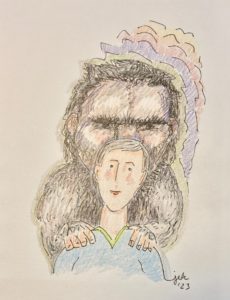
-Artwork © 2024 Jan Ketchel
Thought is the first cause of manifestation. Words are the currency of thought. The words we use create our realities.
Take for example the use of the word my. It’s quite typical for people to refer to a physical condition, such as a migraine headache or cancer as my headache or my cancer when discussing their status.
Though logically it makes sense to refer to a condition one is grappling with as my ________, on a subtle level the use of this possessive adjective grants the condition full citizenship in the physical body. Every time we use the word my we suggest to the subconscious mind that the condition being identified exists in and is a part of me.
Of course, a diagnosis, deemed essential for proper treatment, requires a distinctive name, but once we put the word my in front of it, we plant it as a seed in the fertile soil of the creative substance in the subconscious mind, the very substance that creates and manifests life.
Inadvertently, through the use of the word my, we may be sending suggestions to the subconscious mind that substantiate the very condition we are seeking to eliminate. From an internal family system perspective, the word my can generate an entity that is entitled, because of its my-ness, to be part of one’s internal family. We might then actually feel powerless to insist that it leave us.
An alternative, which bypasses this conundrum, would be to acknowledge the symptoms, diagnosis, and treatment one is working with without claiming personal ownership of it through the use of the word my. For example, one might speak in this manner: “Sometimes I experience headaches that have been diagnosed as migraines. This is the treatment I’m involved with to eliminate the issue.”
Another common misuse of the word my is in the oft-stated phrase, my triggers. The phrase my trigger grants a trigger legitimate entity status and permanent residence in one’s personality. Triggers should actually be treated as transient experiences that reveal the existence of root issues that need to be processed.
The processing of a trigger means to fully neutralize its negative effect upon one’s life. When we say, my trigger, we send the message to the subconscious mind that this is a powerful and permanent condition that must be avoided at all costs. This also results in the expectation that other people take responsibility to both know and avoid provoking these hidden bombs that we house but seek to avoid.
The antidote is to assume responsibility when triggered. Often this requires one to retreat, release activated emotional energy, and then process the root issue that has come to the surface. Triggers should be thanked for their guidance as we track the true culprit of our discontent.
Saying thank you is a powerful way to gain the support and influence of the subconscious mind. Triggers are actually present associations to established habits that the subconscious activates, as per the instructions it receives from established beliefs and suggestions.
By thanking the subconscious for the trigger that enables us to root out its cause, we warmly engage our inner partner, the subconscious mind, in the task of reclaiming our defensive energy and releasing entities we have created to avoid uncomfortable issues.
Thank the subconscious often for its tireless efforts to create the self we ask it to be. For best results, may that intended self reflect the truth of the heart.
Thank you,
Chuck




